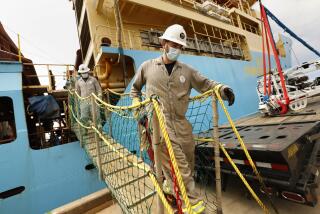Plan to Turn Oil Rigs Into Reefs Fuels Controversy
- Share via
Seven oil platforms off Orange County’s coast nearing retirement could become permanent havens for aquatic life if their owners win a legislative battle to turn them into artificial reefs. But environmentalists say oil companies just want to avoid a costly cleanup.
Underwater invertebrates such as mussels and barnacles attach themselves to the steel towers that support the platforms. Creatures such as strawberry anemones, ochre starfish, rockfish and sea cucumbers gather around the skeletal structures.
Under state and federal law, these supports are to be removed with the rest of the platforms when oil companies decommission the rigs, cap their wells and restore the sea floor to its original condition. But “rig to reef” proponents say these thriving underwater communities should not be disturbed--even when the offshore rigs are no longer in use.
“For most of us, the notion that an oil rig’s anything but an oil rig is unheard of,” said state Sen. Dede Alpert (D-Coronado). “People forget about what lives under the water.”
Alpert has sponsored a bill that would allow oil companies to leave the underwater steel structure in place to act as an artificial reef, even after the platform is removed. Oil companies would save millions of dollars in decommissioning costs, but would still have to pay a substantial sum--perhaps 75% of the savings--into a marine research endowment fund, Alpert said. The California Endowment for Marine Preservation bill probably will come before the Senate Natural Resources and Wildlife Committee early next year.
The Legislature’s decision could determine the fate of seven platforms off Seal Beach and Huntington Beach. These rigs will be decommissioned in the coming decades, some as soon as 2005.
Statewide, 32 rigs will be decommissioned in the next decade. Factors such as shipping traffic and water depth and quality will determine which could be turned into reefs.
“This is a situation where we feel true environmentalists’ interests and industry’s interests could very well be aligned,” said George Steinbach, Chevron Corp.’s decommissioning manager for California offshore areas.
Chevron and other oil companies funded the start-up of the nonprofit California Artificial Reef Enhancement program, which is lobbying for the conversion of rigs to reefs.
“People don’t realize what’s out there,” said Kristin Valette, a program board member. “We’ve already got this ecosystem. It would do more harm to rip [the rigs] out. It would kill a lot of the marine environment.”
Backers say successful rig-to-reef programs exist in Texas and Louisiana. More than 100 Gulf of Mexico rigs have been turned over to the two states and now attract a variety of marine creatures, which in turn attract divers and sportfishermen.
Environmentalists remain skeptical of the proposal.
“A reef is a natural, alive animal system. An oil well is an oil well. It’s absolutely ludicrous to call an oil well a reef,” said Gordon Labedz, a member of the Sierra Club’s Coastal Protection Committee.
The Surfrider Foundation of San Clemente only supports artificial reefs as replacements for natural reefs destroyed by people.
“Our position is that artificial reefs should be looked at when you have an existing reef habitat that’s been impacted by human activity,” said Eve Kliszewski, Surfrider’s environmental director. “We’re skeptical of the [rigs to reefs] concept because it’s basically leaving trash in the ocean. The push toward legislation is premature because we need to know more.”
Susan Jordan, a board member of the League for Coastal Protection, disputes the proposal’s basic premise that a rig could ever be a reef.
“Some people try and say this is a habitat. It’s not--it’s an oil company leaving debris in the ocean. We have a tremendous amount of debris left over by them already,” she said. “The analogy that I use is a telephone pole versus a tree. Just because it sits there, it’s a structure and birds can sit on it doesn’t mean it’s a viable habitat.”
Key to the long-term debate over turning rigs into reefs is determining the environmental benefit. Researchers and environmentalists hope that question will be answered by the time more rigs are decommissioned.
“There isn’t anything that’s happening overnight,” said Warner Chabot, the Pacific region director for the Washington, D.C.-based Center for Marine Conservation. “Let’s do science first and policy second.”
More to Read
Sign up for Essential California
The most important California stories and recommendations in your inbox every morning.
You may occasionally receive promotional content from the Los Angeles Times.











